Throughout all versions of Robot Wars, there were certain robots armed with weapons which did not easily fit into any specific category. These are known as unique weapons. Unique weapons may still act in a similar manner to conventional lifting, flipping, gripping, overhead or rotating types, but function in very different ways. Famous and successful examples of unique weapons include the trap mechanism of Series 4 Semi-Finalist MouseTrap, the Meltybrain drive system of joint Series 10 third-place finisher Nuts 2, and the 'smothering shell' of Series 3 middleweight competitor Tentoumushi.
Definition[]
A unique weapon is designated by the fact that it does not fit into one exclusive weapon category. The trap mechanism of MouseTrap, for example, functioned in the same way as a hammer (Series 4) or bladed axe (Series 5/Extreme 1). However, its shape and dimensions also allowed the weapon to act as a clamping jaw, which MouseTrap used to great effect as the trap held opponents in place while it pushed and dragged them around the arena.
Additionally, there may be unique weapons that do not fit into any category whatsoever. Examples include the 'smothering shell' of Tentoumushi or the 'wagglers' featured on Darke Destroyer 2.
Advantages and Disadvantages[]
Advantages
- Roboteers can often use the custom weapons to fit in with the design of their robot, for both effectiveness and entertainment. MouseTrap's trap weapon and Bucky the Robot's snapping teeth added to their respective themes, the former also proving to be reasonably effective throughout its performances in Series 4-5.
- Creating a new type of weapon grants a robot an element of surprise.
Disadvantages
- It is very difficult to predict whether a unique weapon will be effective in combat without any predecessors to compare it with. As a likely result, the majority of weapons listed below proved to be largely ineffective in practice.
- Other robots which attempt to have unique weapons can have their armament outlawed depending on certain rules and regulations in place for any given series. For example, Double Jeopardy attempted to enter Series 10 with a tethered air cannon weapon, but the producers declined the robot's application due to potential safety concerns.[1]
List of Robots with Unique Weapons[]
Robots are listed alphabetically.
DESKTOP MODE ONLY: Robots which are not heavyweight entries are listed with a green background. House Robots are listed with a gold background.
| Robot | Weapon | Picture | Series Appearances with Unique weapon | Description | Advantages | Disadvantages |
|---|---|---|---|---|---|---|
| 8645T | Combination axe/flipper arm | 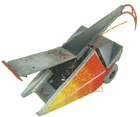
|
Series 5, 7 | The flipper and axe were attached to the same ram, so that when the weapon fired, the axe would lower as the flipper raised. | Protected the front and back of the robot at the same time. The weapons offered good leverage to one another, and the flipper could be reasonably effective. The axe head could be used to pin down and control opponents in a similar manner to a crusher. | It did not allow 8645T to self-right from any position other than on its back. |
| Axios | Wedged 'tongue'. | 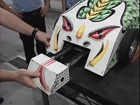
|
Series 3 | Fired out forwards from within the robot's front wedge shape through a twin rack mechanism; supplemented by a lance on an overhead arm. | Intended to 'push' opponents away from the front end; would have offered defence capabilities through its thick construction. Fast-acting. | No damage output; mechanism exposed and vulnerable to being caught or damaged in the fired position. |
| Big Brother | Morningstar mace | 
|
Series 3 | The morningstar functioned as an overhead flail, which would whip back and forth. | Fast attack rate. | Had a very short range and was largely ineffective at causing damage. In addition, the mace was prone to falling off and could be snagged by opponents. |
| Binky | Nose axe and Battle sled | 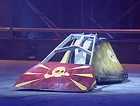
|
Series 3 | Binky's battle sled was a large wedge scoop attached to a frame. The frame, itself attached to Binky's turret body, was capable of rotating around so that Binky's battle sled had a 360 degree range. | Provided a good deal of protection when facing an opponent, as it kept robots at least three feet away from its chassis and internals. | Was very slow in moving around, often required torque from the actual robot to get underneath opponents properly. Taking up a good deal of Binky's 78kg weight, often the body rotated and the battle sled remained still whenever the weapon was used. |
| Broadsword | Medieval broadsword | 
|
Extreme 2 | The sword was a long blade made out of car springs. It was similar to a spear, but had bladed edges, and could damage opponents by swinging the side of the blade into them. | Protected it from spinners, it held off Typhoon for most of their Extreme 2 Middleweight battle. | Was long and unwieldy, struggled to hit low robots and had minimal effect on them if the attack connected. |
| Bucky the Robot | Snapping jaw | 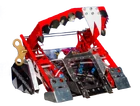
|
Series 10 | Bucky the Robot was inspired by chattering teeth; its jaw used a pneumatic system and a top row of teeth to snap down on opponents. Team Tomco designed their weapon like this to work like a 'flipper in reverse', with instant downward force. Classed as a crusher by Robot Wars: The Official Handbook and described as a Biter Bot in its televised appearance. | Applied a large amount of force onto the top of robots. Could allow the robot to self-right if it was flipped directly onto its back. The two middle teeth proved effective in grabbing hold of opponents by 'biting' through exposed gaps, e.g. Vulture's wedge. | The weapon's position led to many of Bucky the Robot's components being left exposed. It could not re-right the robot from most positions, or if the pneumatics system ran low on CO2. Wedge was too steep to allow weapon to 'bite' consistently. |
| Cronos | Crusher/rear-hinged flipper | 
|
Series 4 | Consisted of a vertical crusher and a rear-hinged flipper mounted together on the same arm. The leverage from the crusher raised the rear wedge, which was supposedly capable of lifting a double-decker bus. Functioned similarly to 8645T, the Series 7 version of Robochicken and the Series 5 version of Sir Chromalot. | Armed both the front and back of the robot at the same time. Useful when attacked by multiple robots. | Ineffective at self-righting. |
| Daisy | Heavy overhead "Skipping rope" | 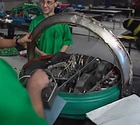
|
Series 3 | Described as a "skipping rope", Daisy's weapon consisted of a thick metal blade which swung over the robot to strike opponents. Very little is known about the weapon, as it, and Daisy, were never seen in action. | The weapon appeared to be able to strike opponents from both the front and back. Its design would have allowed it to act as a srimech. |
Potential reliability issues, although it is unknown whether this was the reason Daisy withdrew. Had a limited attack range and would have struggled against large opponents, such as its would-be opponent, Aggrobot. |
| Darke Destroyer 2 | Spring-loaded "wagglers" | 
|
Series 4 | The "wagglers" were two spring-loaded, sharp pieces of metal that would be fired when they came into contact with another robot, with the intention of slicing through an opponent's armour. | Could be fired at an exceptionally fast rate, useful for scoring aggression points. | Were very weak, and caused minimal damage. |
| Dome | Pneumatic trebuchet | 
|
Series 5 | The trebuchet functioned as an overhead flail, with the "ammunition" a disc attached to the main arm by a chain. | Very fast. | Had limited damage potential and could not act as a srimech during the robot's only battle. |
| Dragbot | Movable Spikes On Wedge | 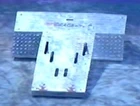
|
Extreme Warriors Season 2 | The spikes could catch opponents and pull them over the wedge towards the robot's rear-mounted cutting disc. | Helped to keep an opponent trapped on the wedge, potentially capable of damaging wheels or tracks. | The spikes were not very effective and also could not help the robot self-right as opposed to regular flippers. |
| Haardvark | Abrasive grinding disc | 
|
Series 3 | One of two interchangeable cutting discs brought for its appearances in this series, along with an unused diamond-edged circular saw.[2] The reinforced blade was designed to grind away at opponents' armour, featuring a smaller metallic layer on the outer face shaped like a traditional sawblade. | Reliable and shatter-proof. Dealt reasonable levels of superficial damage against Henry, including lots of sparks which would have helped emphasise damage and aggression in the subsequent (yet unannounced) Judges' decision.[3] | Less effective than other cutting disc types, especially against tougher armour. The edge of the disc also wore down noticeably as the battle progressed.[3] |
| Havoc | Zinc mace | 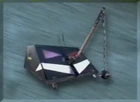
|
Series 2 | Interchangeable with a flipping/lifting arm and a battering ram, the mace was a spiked ball attached to a rod on the top of Havoc by a chain, allowing it to move freely. | Large attack radius. | Ineffective at inflicting damage. |
| Heavy Metal | Rotating arm | 
|
Series 9 | A 360-degree articulating arm with interchangeable weapon tips. The arm could be modified to operate in various different configurations, such as a clamp, a lifter, a thwackbot and a spinning weapon, depending on which opponents Heavy Metal faced. | Could have been effective at side-stranding opponents. The arm could also double as a self-righting mechanism. | Slow, with a rotational speed of 10rpm. Was rather easily damaged in its group battle, thus left it ineffective during the remainder of its heat. |
| Little Nipper | Twin mousetraps | 
|
Extreme 1 | Wielded two mousetraps which each resembled an actual mousetrap. They were intended to bludgeon down on its Antweight Melee opponents whenever they came into range. | Fast, very effective at flipping opponents over in a similar manner to front-hinged flippers. Could double as ramming wedges when in the fired position. | Ineffective as bludgeoners, retracted very slowly. |
| MouseTrap | Trap mechanism | 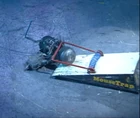
|
Series 4-5 | The weapon was designed to resemble the actual mechanism of a conventional mousetrap. Functioned as a pneumatic, chain-driven overhead weapon, with a heavy bar, and then a guillotine blade in Series 5, as the impacting part of the weapon. Reached a Series Semi-Final and recorded four wins, including a victory over the seeded Evil Weevil, with this weapon. | Was effective as a trapping mechanism; MouseTrap could easily drag robots across the arena once it had slammed the trap down. | Could not function as a srimech. Both the weapon and the chain used to power it were vulnerable to getting damaged, as shown in its battles against Stinger and S3 respectively. |
| Ms Nightshade | Spikes/'petals' | 
|
Series 9 | The robot's weapon consisted of six pneumatic 'petals' with top-mounted spikes, which could act as axes and/or hammers. The 'petals' could also double as a sit-and-spin weapon when fully opened, and the team claimed that they could enable Ms Nightshade to climb out of the pit. Referred to as a spikebot on television. | Fast-acting, gave the robot protection from most sides. | Untested before the robot's first fight; not very damaging. Were unable to act as self-righting mechanisms. Fragile; several were bent out of alignment after the robot was flipped by Apollo during its Group Battle. |
| Nuts | Rotating ring | 
|
Series 8 | A large metal ring surrounding the main robot, capable of rotating independently on a longitudinal axis through a separate electric motor. Equipped with two chain flails functioning as a conventional sit-and-spin weapon. | Enabled lifting and self-righting capabilities; allowed Nuts to comply with the active weapons rule. Offered protection from all sides. | Was mostly a secondary component to the main chain flails; limited damage potential compared to separately-powered spinners. Variable ground clearance; left Nuts more vulnerable against wedges, flippers and lifting weapons. Fragile; ring was removed by Carbide and Terrorhurtz during its Head to Head rounds. |
| Nuts 2 | Meltybrain spinner | 
|
Series 10 | An LED/motion detection-based drive system, working in tandem with the main robot's interchangeable rings and chain flails. | Significantly more damaging than traditional sit-and-spin designs; less expensive and more reliable than conventional spinners through not requiring as many moving parts. Flexible design through the implementation of interchangeable rings/flails. Considered an active weapon under the Robot Wars rules unlike most other sit-and-spin designs. |
Effectiveness reduced by the main robot's limited traction on the arena floor; could be nullified by malfunctions or direct damage to the drivetrain and/or rings. |
| Piranha | Spiked Titanium Blade | 
|
Extreme 2 | The weapon was a large swinging serrated blade functioning similarly to an axe or hammer. | Was fast-acting in the first few swings. | Not very powerful or damaging. Speed and power decreased significantly after the first few swings. Untested - and unproven - self-righting capabilities according to the robot's statsboard. |
| Recyclopse | Steel wedge tongue | 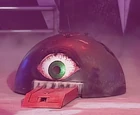
|
Series 1 | Fired forwards from the base with a reach of over 90cm. A conventional front-hinged flipper - the first of its kind - was integrated into the mechanism, for throwing other robots which had driven or become stuck on the tongue. Grand Finalist with this weaponry. | Very fast-acting; effective at breaching high ground clearances. | Limited effectiveness as a weapon compared to the flipper within. Nullified by robots with lower ground clearances. |
| Revolution 2 | 36" vertical blades | 
|
Series 6, Extreme 2 | Six extremely large vertical blades attached to a spinning drum mechanism. The robot could run inverted, and its blades were upgraded to be much thicker in Extreme 2. | Offered a large range of attack, with high speeds of 200mph. | The blades would halt upon contact with other robots, and no individual blade was particularly heavy. |
| Roter Ochse | 'Demolition Hammer' | 
|
Series 2 | The weapon operated like a jackhammer, with the intention of denting and buckling other robots' armour. Strong enough to damage the arena side wall, but not seen in action in televised highlights of Roter Ochse's Super Heavyweight qualifier. | Proved very powerful and destructive. | Only worked on slow or immobile opponents. Mounted high, likely too high for it to hit most low-profile robots. |
| Sir Chromalot | Combined axe/flipper | 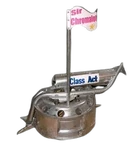
|
Series 5, Extreme 1 | The flipper's gas bottle was mounted on the arm itself, and had a spike attached to the rear end which acted like an axe when the arm was raised. It functioned akin to 8645T and Robochicken. | Ability to attack from the front and back at the same time. | Inaccurate, prevented Sir Chromalot from self-righting after being flipped by Firestorm 3. |
| Sting | Whipping tail | 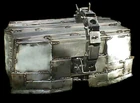
|
Series 2-3 | Dubbed as a 'scorpion tail' in Series 2, consisted of an articulated assembly of steel sections[4] designed to 'whip' back and forth using a flywheel-based mechanism. Initially fitted with narrow spikes in Series 2, later redesigned for Series 3 with a larger spiked head. | Easy to use multiple times in quick succession, capable of chipping tougher materials such as titanium in the original narrow spike configuration. | Ineffective at causing significant damage (especially in later series), narrow attack range, limited accuracy depending on the angle of the 'head' as it struck. |
| Tentoumushi | 'Smothering Shell' | 
|
Series 3 | Consisted of an electric arm with a plastic sandpit lid, itself concealing a small cutting disc. The shell was used to grab hold of opponents, allowing Tentoumushi to either use its disc to damage them or drag them around the arena while keeping them trapped underneath. Used to great effect in both the Middleweight Melee and the Series 3 War of Independence. | Could easily control an opponent by trapping it with the 'smothering shell'. Offered an effective weapons synergy with the disc. |
Was necessarily fragile. |
| The Sentinel | Spiked club on a modified Hanix[5] excavator arm | 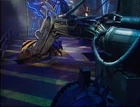
|
Series 2 | Intended to push, block and pin robots against the wall or arena floor when they attempted to pass it, as well as to cause damage to their armour, and steer them into other House Robots or a nearby pit. Mounted on a turret that could turn 180 degrees, later 360 degrees in the Semi-Finals, with the arm and club able to lift and lower independently of each other. | Capable of stopping competitors from moving; was shown to damage, immobilise and even lift robots on occasions. The turret allowed for a wide range of attack from each of The Sentinel's designated positions, especially in the Semi-Final Gauntlet stages. | The club could not be used outside of The Sentinel's positions, as the machine's tracks were purposely enclosed. Required a human operator inside the arena. Both the arm and the club could also be damaged. |
| The Spider | Rotating spikes | 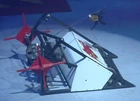
|
Extreme 1 | Two cross-shaped blades at each end of a horizontal shaft, allowing the spikes to spin vertically together. | Covered both sides of The Spider's front using only a single mechanism. | The blades were comparatively lightweight. Both the weapon motor and chain were also exposed, potentially leaving these components vulnerable to damage. |
| Toecutter | Spring-loaded blade | 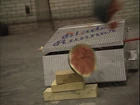
|
Series 3 | The blade was a 5kg blade attached to a clay pigeon trap mechanism, which when fired was intended to slice through an opponent's armour. | Was very fast and could be fired in rapid succession. | Did not prove very powerful or damaging, had a short attack reach. Low-profiled robots could avoid the blade entirely. |
| Twister (Dutch) | Spinning Triangle | 
|
Dutch Series 2, Series 7 | Armed with a triangular spinner with blunted vertices that acted as hammers. The entire outer triangle was thick enough to cause damage. The weapon was mounted at a 45-degree angle in Dutch Series 2 and horizontally in UK Series 7. Due to its unusual shape, Twister's weapon cannot accurately be classified as a flywheel or a conventional bar spinner. | The weapon was well-designed, with much of its weight away from the central axis. It was highly capable of damaging and immobilising opponents, especially in the 45-degree configuration. |
The 45-degree orientation left the robot precariously off-balance. The horizontal configuration left the space in between the vertices exposed - if that was the point of impact the triangle would glance harmlessly off the opponent and be left unable to spin up. |
References[]
- ↑ Evan Woolley, captain of Team Double Trouble, on Reddit
- ↑ http://web.archive.org/web/20040202004052/http://www.haardvark.connectfree.co.uk:80/1999.htm
- ↑ 3.0 3.1 http://web.archive.org/web/20040219100131/http://www.haardvark.connectfree.co.uk/1999film.htm
- ↑ http://web.archive.org/web/20000308030630/http://www.users.globalnet.co.uk/~barker03/workshop.htm
- ↑ Robot Wars Revealed, Episode 8, 05:06
[]
| ||||||||||||||||||||||||||||||||
